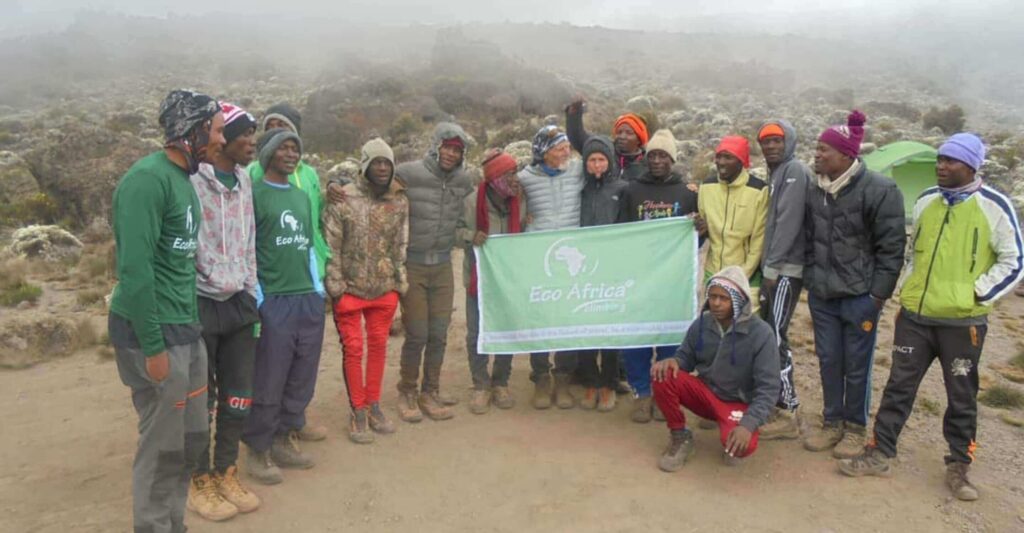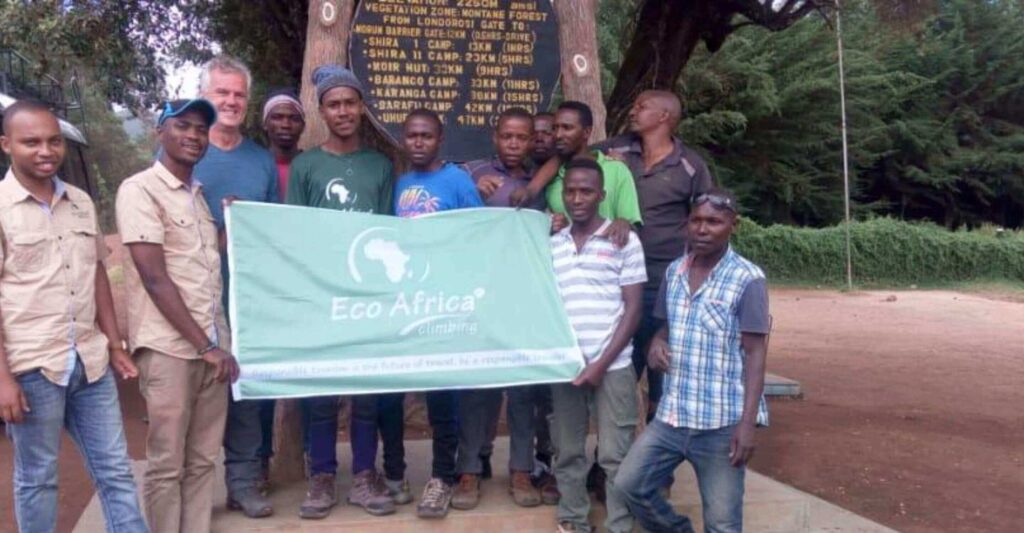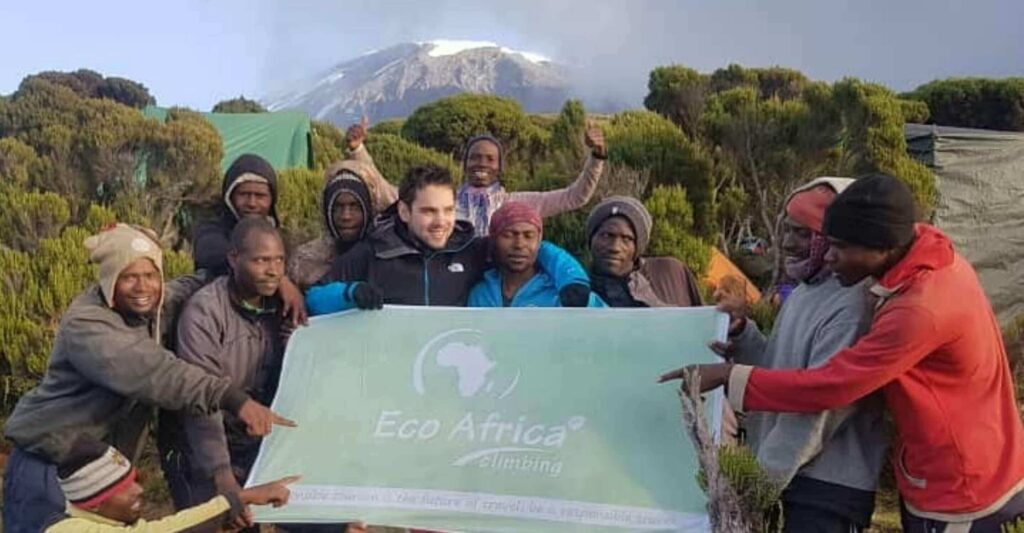KILIMANJARO ALTITUDE TRAINING
HOW DO I TRAIN FOR THE HIGH ALTITUDE KILIMANJARO CLIMB?
There are a lot of different opinions when it comes to Kilimanjaro altitude training. The biggest challenge most trekkers face on their Kilimanjaro climb is acclimating to the thinner air they encounter as they climb.
The effects of altitude are why climbers fail to reach the summit. Altitude is a great equalizer: no matter how physically fit and strong you are, you can still develop acute mountain sickness.
This article will focus on strategies you can use to give you the best chance of acclimatization and preparing for Kilimanjaro’s altitude.
We have a complete training resource if fitness preparation is your goal.
Can you train for altitude?
Yes and No.
Unless you live and train at altitude, you can’t replicate what it will be like when you are on the mountain. If you live near some peaks, do acclimatization hikes before your Kilimanjaro trek to better understand how your body reacts to the thin air above 10,000 ft.
Scheduling an overnight hiking trip in the mountains can give your body a chance to experience the thinner air and what it’s like exerting yourself.
For many people, that’s not an option.
Many people who climb Kilimanjaro do so with no prior high altitude experience. Altitude sickness can prevent a successful summit, no matter how fit, determined, or prepared you are.
Effects of Altitude on your body
See our complete guide to Kilimanjaro altitude for a more in-depth look at the effects of altit1ude.
At Kilimanjaro’s summit, 49% less oxygen is available than sea level. Your body needs to adapt to compensate for less oxygen is delivered to your muscles and brain with every breath.
Altitude Sickness (AMS) is an original and dangerous condition. However, many people experience some of the effects of altitude without developing AMS.
Some symptoms you might notice:
- Breathing deeper and faster.
- Higher pulse rate, even when resting.
- Elevated blood pressure.
- Difficulty sleeping
- Headaches and fatigue
What about physical fitness?
Your physical fitness will not affect your ability to acclimatize. Your body needs time to make the compensatory changes necessary to operate in the lower-oxygen environment.
The more you have to exert yourself at altitude, the more difficulty your body may have adapting. So physical fitness can mean the difference between 60% exertion at 14,000 ft or 85% at the same elevation.
According to the US Army Research Institute of Environmental Medicine, “sustained physical exertion early in the altitude exposure substantially increases AMS incidence and severity.”
So while being physically “fitter” than others will not increase your body’s ability to acclimatize, it can be the difference between how intense the exertion feels.
Additionally, sometimes very fit athletes will tend to move faster, push through their symptoms, and exert themselves more than less fit climbers.
The key may be to hike well below your physical limits to help your body adapt and reduce fatigue.
Altitude Training at Home or the Gym
Elite athletes have been using “altitude training” to increase their physical performance for many years. Either by going to train in the mountains or by using altitude simulators. Using these techniques as “pre-acclimatization” methods for mountaineering is becoming more popular, with mixed anecdotal reviews and some encouraging scientific studies.
The main difference between accurate altitude and simulated altitude is that the air pressure decreases as you go to higher elevations, which lowers the available oxygen.
Since the at-home (or gym) systems can’t replicate the low atmospheric pressure, they won’t ever be as effective as traveling to and spending time in the mountains.
See the US Army’s guide to Effectiveness of Preacclimatization Strategies for High-Altitude Exposure.
A Brief Look at Altitude Training Systems
Bear in mind that most people who summit Kilimanjaro successfully have not used any of these systems. Our gradual acclimatization protocol, combined with a slow and steady ascent, gives climbers the best chance of avoiding any issues.
Altitude Tents (Sleeping in a Low Oxygen environment)
What?
We’ve all heard athletes talking about getting a competitive edge from the “sleep high, train low” system of sleeping in a low oxygen tent. Introduced by Benjamin Levine and James Stray-Gundersen in 1997, this technique gives the athlete the physiological adaptations to a low-oxygen environment (during rest) without compromising training performance (done at sea-level).
How?
You put a special tent around your bed, connect it to a hypoxic generator (the machine mixes nitrogen with oxygen, lowering the amount of available oxygen), and sleep. You get up in the morning and go about your usual training practice.
Using the settings on the hypoxic generator, you gradually sleep “higher” for 4-6 weeks before your Kilimanjaro trip. The idea is that you gradually get used to the thin air, and your body adjusts.
These systems can be purchased or rented from various providers, such as Hypoxico in the US.
Does it help?
In our opinion, the jury’s out on whether or not it helps you acclimatize. It’s impossible to state whether it ” works with so many variables, such as your genetic predisposition to acute mountain sickness (AMS), your health, and any pre-existing conditions, it’s impossible to state whether it “works.”
According to Hypoxico, who rent and supply these systems, there are many health and athletic benefits to sleeping in a thin air environment.
Read the science: Sleeping in moderate hypoxia at home to prevent acute mountain sickness (AMS): a placebo-controlled, randomized, double-blind study.
Training in an Altitude Chamber (or with a Mask)
What?
Exercising in normobaric hypoxia (low oxygen at sea-level) appears to optimize oxygen delivery to your muscles and organs, reducing fatigue and allowing your body to start making the compensatory changes it needs to perform with less oxygen.
Some of the benefits include:
- Reduced symptoms & incidence of Acute Mountain Sickness (AMS)
- Higher blood-oxygenation levels at altitude
- Greater work tolerance/exercise capacity at altitude
How?
Some gyms in major cities have installed altitude chambers, low-oxygen environments containing treadmills, stationary bikes, and other cardiovascular machines. You go in there and do your regular training program (for Kilimanjaro, you might walk at a steep gradient on a treadmill) and get used to the thin air.
Alternatively, you can rent or buy these systems to use at home.
Does it help?
It’s certainly hard work! A workout that you’d typically do with relative ease is made much harder with the decreased oxygen. Your body has to work harder to maintain the oxygen supply to the tissues, resulting in physiological adaptations similar to acclimatization.
Numerous studies are showing the benefits of exercise at simulated altitude:
https://www.ncbi.nlm.nih.gov/pubmed/26089545
https://www.ncbi.nlm.nih.gov/pubmed/25332006
A note on “Mask Systems.”
There is some confusion amongst trainees about so-called “mask systems” for altitude training.
The two main types:
- Mask systems that you use in a gym or at home, connected to a hypoxic generator that delivers a lower concentration of oxygen by mixing nitrogen into the air, such as these. This system provides the same benefits as exercising in an altitude chamber.
The second type is the cheap device you can buy on Amazon, restricting your breathing. There is no evidence to suggest that these products have any benefit at all. If you want to limit your breathing, you can wear a dust mask or something similar.
Intermittent Hypoxic Exposure (at rest)
What?
IHE is a protocol of breathing short bursts of low-oxygen air through a mask, followed by breathing normal air while sitting in a chair.
There are various protocols, but all involve breathing low-oxygen air for around five minutes while monitoring your blood saturation with a pulse oximeter, followed by five minutes of breathing normal air. (Times can vary depending on your adaptation).
The idea is that it prompts the body to adapt to hypoxia.
How?
A mask system is connected to a hypoxic generator, and you adjust the settings to deliver the % of the oxygen you want. Typically, you’d start with reducing the oxygen level to 18%, then down to 15%, and lower still as your body adapts.
It’s essential to use a pulse oximeter to monitor your oxygen saturation to ensure it stays in the optimal “training” zone. Consult a professional if you are just getting started.
You can rent or buy these systems, and many people praise the benefits of health, body composition, and performance.
Does it help?
Many testimonials from the equipment providers report that this method of pre-acclimatization helps. Numerous studies show the benefits of IHE, so we encourage you to do further reading or consult a professional specializing in this protocol.
https://www.altitudecentre.com
https://www.ncbi.nlm.nih.gov/pmc/articles/PMC6135973/
https://www.ncbi.nlm.nih.gov/pmc/articles/PMC2465425/
https://www.ncbi.nlm.nih.gov/pmc/articles/PMC2465425/
Other Tips
- Arrive in Tanzania at least a day or two before your climb. Allow yourself to recover from the traveling, adjust to the time change and get a good rest before starting your climb.
- “Pole Pole” is a Swahili word meaning “slowly slowly” you’ll hear it a lot on your trek. Take your time on the mountain: don’t hike at the front of the group; conserve your energy no matter how fit you are
- Stay hydrated. The dry air and exertion cause you to dehydrate quickly. Be sure to drink plenty of water and consider an electrolyte additive to keep your minerals in balance. Dehydration significantly impairs physical performance.
- Eat carbohydrates. You need those carbs no matter what dietary plan you follow at home. Studies have shown that a diet high in carbohydrates at altitude will stimulate ventilation and improve blood oxygenation. Adequate carbohydrates keep your muscle glycogen replenished, maintain blood sugar levels during exertion, and speed recovery.
Consider using Diamox. Please consult your doctor to determine whether this medication is proper for you. Read more about Diamox here.
Got questions? We’re here to help.
Note: You should consult your healthcare professional before undertaking any hike or climb. Nothing in this article or any information is designed to diagnose, treat, prevent, or cure any condition. Please consult your healthcare professional before making any changes to your current lifestyle.
Our Top Recommended Ethical Kilimanjaro Climbs
Ethical Kilimanjaro via Northern Circuit Route 9 Days
The Northern Circuit route is one of the best routes on Kilimanjaro.The route approaches Mount Kilimanjaro from the west….
From USD $3250
Ethical Kilimanjaro via Lemosho Route 8 Days
The Lemosho route is one of the newer routes on the mountain and a superb choice for your climb, It is our preferred route…
From USD $2950
Ethical Kilimanjaro via Machame Route 7 Days
Machame (“Whiskey”) Route is also known as the “Whiskey” route, the Machame route is now the most popular route on the …
From USD $2650


